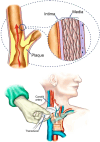Improvement of carotid atherosclerosis and peripheral artery disease after hepatitis C virus eradication by direct-acting antivirals
- PMID: 38184828
- PMCID: PMC10863684
- DOI: 10.47162/RJME.64.4.04
Improvement of carotid atherosclerosis and peripheral artery disease after hepatitis C virus eradication by direct-acting antivirals
Abstract
Introduction: Recent research points to a link between chronic hepatitis C virus (HCV) infection and cardiovascular disease, especially carotid atherosclerosis, and suggests that HCV clearance may impact cardiovascular outcomes.
Aim: To determine if viral eradication by the new oral direct-acting antiviral (DAA) agents has benefit regarding carotid atherosclerosis, peripheral artery disease (PAD), steatosis, and liver fibrosis.
Patients, materials and methods: We conducted a prospective study on 168 patients diagnosed with chronic HCV infection or HCV-related cirrhosis. They were all treated with DAAs, with sustained virological response (SVR). Laboratory data, vibration-controlled transient elastography (VCTE), carotid intima-media thickness (IMT) measurement, and ankle-brachial index (ABI) were recorded in all patients.
Results: We found an average IMT of 1.22±0.2 mm, with a variance range from 1.14±0.19 mm in the mild and moderate fibrosis (≤F2) group to 1.29±0.25 mm in the severe fibrosis (≥F3) group. Also, patients with severe fibrosis (≥F3) present a more critical decrease of IMT values, with the carotid thickness affecting only 18.2% of individuals in the follow-up period. At the baseline, the best values of ABI were recorded in patients having F1-F2 fibrosis stage (mean value 1.02±0.19). Instead, in the group with severe fibrosis, the average value of ABI was lower (0.91±0.16) at the baseline, with a significant increase at SVR evaluation (p<0.001).
Conclusions: Our research highlights the beneficial effect of viral eradication on both carotid atherosclerosis and PAD, especially in those with advanced fibrosis and cirrhosis.
Conflict of interest statement
No conflict of interests is disclosed by the authors.
Figures





Similar articles
-
Hepatitis C virus eradication by direct-acting antiviral agents improves carotid atherosclerosis in patients with severe liver fibrosis.J Hepatol. 2018 Jul;69(1):18-24. doi: 10.1016/j.jhep.2018.02.015. Epub 2018 Mar 2. J Hepatol. 2018. PMID: 29505844
-
Carotid Intima-media Thickness and Small Dense Low-density Lipoprotein Cholesterol Increase after One Year of Treatment with Direct-acting Antivirals in Patients with Hepatitis C Virus Infection.Intern Med. 2019 May 1;58(9):1209-1215. doi: 10.2169/internalmedicine.1514-18. Epub 2019 Jan 10. Intern Med. 2019. PMID: 30626818 Free PMC article.
-
Hepatitis C virus eradication by direct antiviral agents abates oxidative stress in patients with advanced liver fibrosis.Liver Int. 2020 Nov;40(11):2820-2827. doi: 10.1111/liv.14608. Epub 2020 Aug 4. Liver Int. 2020. PMID: 32666695
-
Reversion of disease manifestations after HCV eradication.J Hepatol. 2016 Oct;65(1 Suppl):S95-S108. doi: 10.1016/j.jhep.2016.07.039. J Hepatol. 2016. PMID: 27641991 Review.
-
Postsustained Virological Response Management in Hepatitis C Patients.Semin Liver Dis. 2020 Aug;40(3):233-239. doi: 10.1055/s-0040-1702944. Epub 2020 Feb 27. Semin Liver Dis. 2020. PMID: 32107758 Review.
References
-
- Dore GJ, Ward J, Thursz M. Hepatitis C disease burden and strategies to manage the burden (Guest Editors Mark Thursz, Gregory Dore and John Ward) J Viral Hepat. 2014;21(Suppl 1):1–4. - PubMed
-
- Cacoub P, Gragnani L, Comarmond C, Zignego AL. Extrahepatic manifestations of chronic hepatitis C virus infection. Dig Liver Dis. 2014;46(Suppl 5):S165–S173. - PubMed
MeSH terms
Substances
LinkOut - more resources
Full Text Sources
Medical
Miscellaneous

